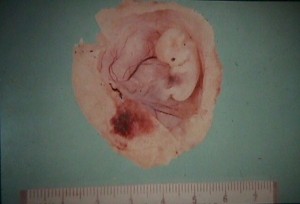A complete abortion means that all tissue has been passed through the cervix.
This is the expected outcome for a pregnancy which was not viable from the outset. Often, a fetus never forms (blighted ovum).

The bleeding and cramping steadily increases, leading up to an hour or two of fairly intense cramps. Then the pregnancy tissue is passed into the vagina.
An examination demonstrates the active bleeding has slowed or stopped, there is no tissue visible in the cervix, and the passed tissue appears complete. Save in formalin any tissue which the patient has passed.
RH negative women receive an injection of Rhogam (hyperimmune Rh globulin) within 3 days of the abortion. It may still be effective in preventing Rh sensitization if given within 7-10 days.
Following a complete abortion, women are encouraged to have a restful day or two and a follow-up examination in a week or two. Bleeding similar to a menstrual flow will continue for a few days following the miscarriage and then gradually stop completely.
A few women will continue to spot until the next menstrual flow (2-6 weeks later). A pregnancy test is not helpful in these situations, as clinically significant levels of HCG will remain in the mother’s bloodstream for weeks following a complete abortion. The mean time to HCG washout is about 30 days.
Women seeking another pregnancy as soon as possible are often advised to wait a month or two to allow them to re-establish a normal uterine lining and to replenish their reserves. Prolonged waiting before trying again is not necessary.
Some physicians recommend routinely giving a uterotonic drug (such a Methergine 0.2 mg PO TID x 2 days) to minimize bleeding and encourage expelling of any remaining fragments of tissue. It also may increase cramping and elevate blood pressure. Antibiotics (such as doxycycline or amoxicillin) are likewise prescribed by some.
If fever is present, IV broad-spectrum antibiotics are wise, to cover the possibility that the complication of sepsis has developed. If the fever is high and the uterus tender, septic abortion is probably present and you should make preparations for D&C to remove any retained products of conception that might prolong the recovery.
If hemorrhage is present, bedrest, IV fluids, oxygen, and blood transfusion may be necessary. Continuing hemorrhage suggests an “incomplete abortion” rather than a “complete abortion” and your treatment should be reconsidered.
